A Gallery of Mansion Movie Scenes: Endings
Departure, Death, Destruction and/or Decay,
Dejection. Desolation, Despair, Depression Dysfunction
Acquiescence, Isolation, Entombment,
Restoration, Reconciliation, Realignment, Repositioning, Resignation
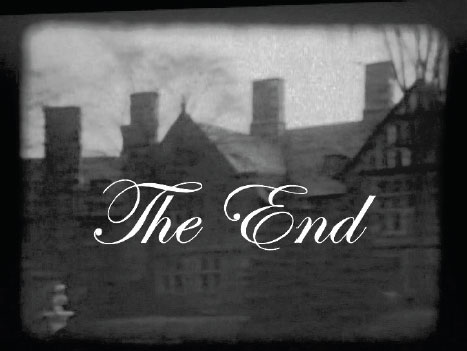
Mansion movies endings are often not happy ones and, even if they end on an ostensibly upbeat note, the audience has a sense all may not bode well for the protagonists given their personalities, temperaments and conflicts played out in the plot. Other than those that would otherwise be classified as romantic comedies, most mansion movies end with a sense of despair. The state or physical condition of the film’s iconic mansion setting usually symbolizes the prospects for the protagonists left standing. If the endings involve death, the mansion comes into disrepair, decay and sometimes near total destruction. More positive endings often involve departure -‐ temporary or permanent -‐ as a way of salvation. If the hero, heroine or family remains in possession of the house, there is a foreshadowing of future loneliness, isolation, and stagnation. In general mansion movies reflect the conventional idioms that money does not buy happiness and perhaps, if not “the root of all evil,” wealth and privilege may cause generational discontent and dependency in those to the manor born. This is often the case whether or not the underlying novel or play from which the mansion movie was adapted contained the same message.
This is many ways satisfies or sates the protagonist outsider’s and the audience’s initial sense of envy or antagonism towards those that live in the mansion. Whether we call it “just desserts,” “come-‐ uppance,” or the belief that “the mighty must at some time fall” there is often a conscious or unconscious feeling of shadenfreude by the outsider and the audience alike, a satisfaction or pleasure out of any indication of ultimate misfortune of the insiders. Most mansion movies -‐ being cautionary tales or fables with respect to the human condition -‐ end with great losses or indicate portents for troubled or bittersweet future for those characters who survive up to and beyond “The End” of the film. The examples of romantic mansion movies that end on an upbeat note, such as “My Man Godfrey,” “Holiday,” “The Philadelphia Story” and “Sabrina,” the likelihood of an ongoing happy future for cross-‐class or mismatched couples involved seems somewhat uncertain.
For the audience, the tragic or sad endings do not linger long after the film is over. Mansion movies intensely engage us, bringing us into the story by the means of the camerawork. We empathize with and often viscerally experience the emotional ups and downs of both the outsider and insider protagonists. But when the lights go on after “The End” title and all the credits disappear from the screen, we leave the mansion movie otherworldliness encountered behind and re-‐enter the everyday ordinary world outside.
ATTENTION! SPOILER ALERT!
If don’t know these films already and you don’t like “spoilers,” stop here.
Restoration Fairy Tale Fantasy
“The End” My Man Godfrey

Godfrey, the rescued “forgotten man” who became the butler to the Bullock family, temporarily hocks Cornelia’s necklace and invests the proceeds, enabling him to help the Bullocks out of potential financial ruin. He follows a dream of putting all the homeless people who lived at the dump back to work in an elegant restaurant and café, called “The Dump” that he and his old friend have financed together. Lovesick Irene Bullock, determined to get her man in the end, arrives with a basket of goodies to give away to Godfrey’s old friends. In her inimitable style she runs slapstick circles around Godfrey and convinces him to marry her on the spot. This “feel good “ending digresses from the ending in Hatch’s short novel. Although nearly all Depression Era movies (and most films generally) negatively stereotype the rich and some savagely mock and vilify them, My Man Godfrey is an example of the gentler “we’re in it all together” thrust of those Hollywood films that sought to unify the country during the worst economic crisis we faced as a nation.
Realignment, Departure and Escape
“The End”: Holiday
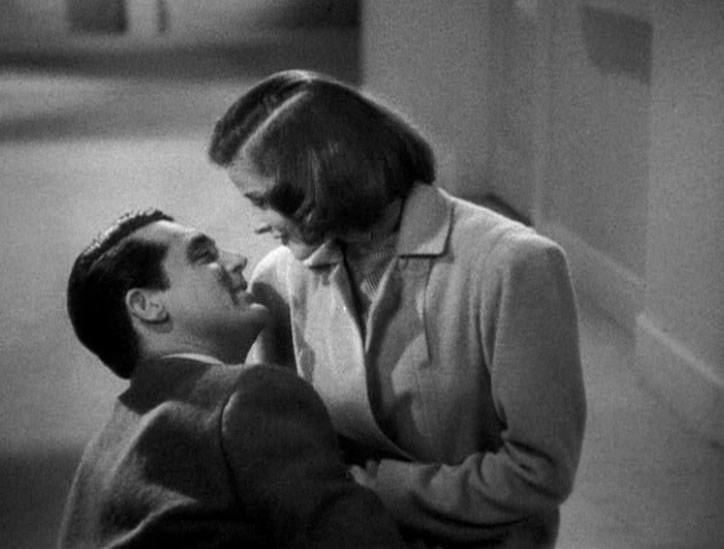
Johnny Case (Cary Grant), after first trying to conform to his fiancée Julia’s (and her father’s) plans for his future, asks Julia to elope with him and leave everything behind for an extended holiday in Europe. He comes to realize that if he postpones his dream of traveling the world and instead works at his father-‐in –law bank and joins the Seaton social circle, he will be stuck in that life until old age. Julia likes her lifestyle and does not understand Johnny’s aims nor wants to wander the world with him. Her sister Linda (Katherine Hepburn) has secretly loved Johnny, but out of loyalty to Julia has hidden her feelings. Julia’s final rejection and her denouncement of Johnny, changes everything. Linda can now openly express her love and admiration for Johnny and she leaves the Seaton home to join him on shipboard, hoping that he will want her. He does and they sail off together.
Reconciliation, Realignment, Repositioning
The End: The Philadelphia Story
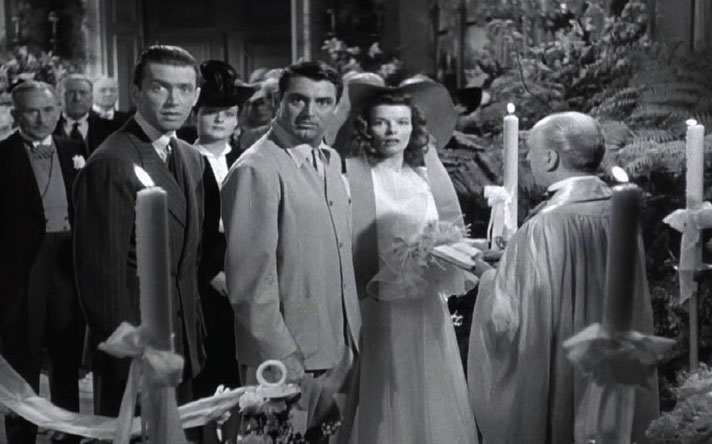
McCauley Conner (James Stewart) and Liz Imbrie (Ruth Hussey) act as impromptu witnesses to the re-‐marriage vows of C. Dexter Haven (Cary Grant) and Tracy Lord (Katherine Hepburn) in the Lord mansion’s south parlor. Despite Conner’s earlier competition for Tracy’s affection, he is happy the intended groom, Tracy’s stuffy fiancé George, has wrongly accused her of unfaithfulness and left her in the lurch. After the guests are seated and waiting for the ceremony to begin, Haven, who has never stopped loving Tracy, offers to step up and re-‐marry his tempestuous ex-‐wife to save embarrassment. Despite the “happy ending,” with the starring couple reconciled, the film doesn’t end with everyone smiling, but leaves us with this lasting, iconic still shot of the wedding party caught off guard when they have been captured on camera by an unwanted and uninvited guest, editor Sydney Kidd. They know that despite all efforts to curtail further damaging articles about the family from being published by the infamous editor, Kidd is sure to sensationalize the last-‐minute switch of grooms in his next issue of his gossipy Spy magazine.
Death and Decay Reconciliation and Realignment
The End: The Magnificent Ambersons

The beginning of the end of the film starts with the death of Isabel Amberson Minafer and shortly thereafter her father Major Amberson and decline and the loss of the Amberson family fortune. In the first screen shot above Fanny Minafer (Agnes Moorehead) and her nephew, Isabel’s son, George Amberson Minafer (Tim Holt), are in the Amberson mansion for the last time; sheets cover the furniture and the heat is turned off in the abandoned house. Screen shot two shows George’s perspective as he rides down the street . He sees the eruption of tall, closely packed new buildings as evidence of the destruction of his pastoral Mid-‐western town as it changes into an industrial city. George abandons the study of law to work in a dangerous job so to make enough money to support himself and his Aunt Fanny. He gets his further comeuppance when he is hit by car and hospitalized.. Eugene Morgan and his daughter Lucy visit George in the hospital; it is suggested that the young couple will get together again in the future. Screen shot three, the film’s ending scene, shows Eugene (Joseph Cotton) and Fanny walking down the hospital corridor smiling. Eugene expresses his feeling that Isabel’s spirit is at peace knowing he will be there to shelter her beloved son. After negative previews of the film, much of the Welles’ dark footage of the changed town were cut and this cloyingly happy final scene was added by Robert Wise and others in opposition to Welles’ intention of ending with an emphasis on the decline of the family and decay of the town. It is often the strongest point of criticism about the severe editing done to Welles’ classic film. It should be noted that Booth Tarkington’s novel also ends with Eugene’s words and sense of spiritual consolation and peace.
Dejection, Desolation, Despair, Depression Acquiescence, Isolation, and Entombment,
The End: The Heiress

The screen shot above superimposed by “The End” title signage is the actual closing shot of the film. Morris Townsend (Montgomery Clift) has returned to New York after an absence of twenty or so years. Those many years before he had jilted Catherine Sloper, ostensibly because she would lose her inheritance if they married against the wishes of her father. When he returns, Catherine tells him she will give him a second chance and once again agrees to elope with him. However, moments before this ending scene, Catherine, now an elegant but bitter spinster, deliberately bolts the door. When Morris arrives at the Washington Square house at the appointed time to fetch her, she refuses to let him in. She ignores his desperate knocking and his crying out to her, and solemnly ascends the stairs of the home will live now alone in for the rest of her life. She has deliberately and cruelly rejected him in retaliation of and in retribution of his rejection of her in the past. The home that was her womb will now become a lifelong tomb. This 1949 black and whiter film was an adaptation of a Broadway play based on Henry James’ novel Washington Square; both end with this tragic and dramatic closing scene. The remake of the film in Technicolor in 1997, based directly on the novel and titled Washington Square, ended on a different note. As the novel does, it further deals with Catherine’s life after her rejection of Morris; with her finding some happiness and satisfaction in later life in her extended family and a role as a teacher. Although the remake won some critical acclaim, it was a commercial failure. The Heiress play and the 1946 film dealt with the story of as one of human tragedy. It is interesting that Robert Wise in directing The Heiress, his very own film based on a classic novel, reversed what he did in meeting the studio demands to “fix” The Magnificent Ambersons.
Death and Descent into Madness
The End: Sunset Boulevard
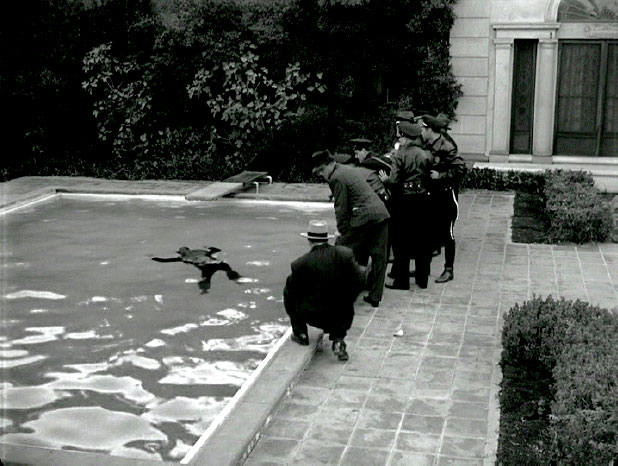
Death comes to Joe Gillis (William Holden) after he renounces the unsavory life he has been living as the paid companion to the aging former silent screen star, Norma Desmond, and is ready to leave Hollywood, go home to Ohio and make a new start. He has driven away young Betty Schaeffer who was in love with him because he feels he doesn’t deserve her and she would be happier with someone else. He confronts Norma with the revelation that the fan letters that she has received over many years were written by her loyal butler Max. He packs, leaving behind the handsome clothes Norma has bought for him and all the expensive gifts she has bestowed on him, and walks out of the house with only the few possessions he came with. Norma in a rage over his words and his harsh words and his rejection of her, runs after him, shoots him in the back several times until he falls dead into her outdoor swimming pool. The police and photographers called to the site find his him there. The image of his dead body face down floating in the pool was shown at the very beginning of the film and in the above screen shot close to the end of the film, bringing the long flashback segment, which is the main structure of the film noir style story, full circle.
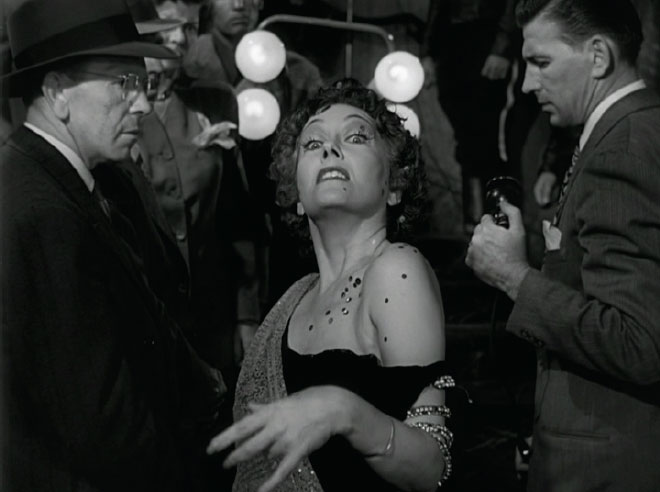
After shooting Joe, Norma Desmond (Gloria Swanson) retreats upstairs to her room, not fully knowing what she has done. She seems to be in shock. While the police, reporters and photographers watch from below, Max, her devoted former director and ex-‐husband who has remained with her for decades as her servant, coaxes her down the stairs by asserting his authority as a film director. He tells her the cameras are ready and waiting to film her as Salome descending the stairs in the palace scene for her come back role. Her descent down the stairway parallels she descent into madness. At the bottom of the steps she speaks directly to the camera “just us, the camera, and those wonderful people out there in the dark!” She ends with the one of the most famous movie quotes:
All right “Mr. de Mille, I am ready for my close-‐up.”
Descent into Madness, Death and Departure
The End: The Haunting
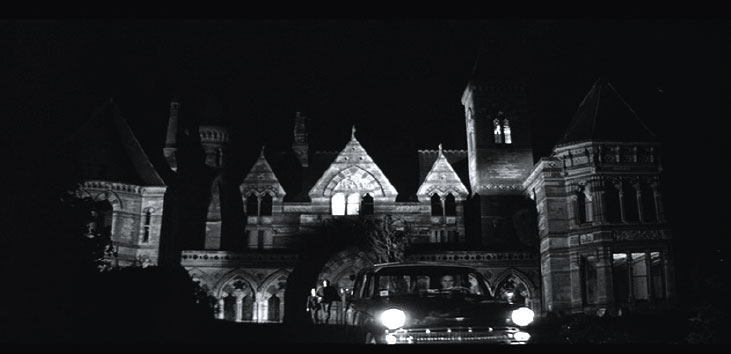
After the last night of fright and terror at Hill House, Dr. Markway decides the mentally distraught Eleanor Lance (Julie Harris) must leave the experiment at the aged isolated mansion for the sake of salvaging her remaining sanity. Luke Sanderson, the nephew of the owner is charged to accompany Eleanor back to Boston. She cries out in protest that the house wants her and she wants to stay, as she has no real home of her own to return to. The other members of group staying at Hill House for the study of psychic phenomena watch helplessly as Eleanor suddenly drives off by herself in an emotional state of mind. The scene of her driving off, with the silhouette of the house dominating the screen behind her, is reminiscent of the eerie look of the mansion and its portent of danger in the arrival scene.
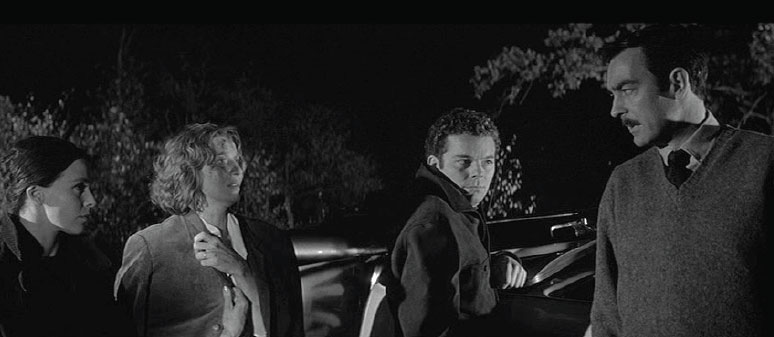
Eleanor’s car seems propelled beyond her control and she crashes into a tree while trying to avoid hitting the white-‐clad figure of Mrs. Markway crossing the road. Eleanor dies at the very place the first Mrs. Crane died in her carriage accident some nine decades before. Shown above, the surviving members of the psychic study group are left somber and horrified. Theo (Claire Bloom), Grace Markway (Lois Maxwell), Luke (Russ Tamblyn) and Dr. Markway (Richard Harris), the leader, are in a shell-‐shocked state. They feel the evil house itself has somehow caused Eleanor’s death. Markway says, “Call it what you like, but Hill House is haunted.” Theo says, “She had no place else to go. The house belongs to her now, too. Maybe she is happier.” The group decides to leave the place immediately and to never return. Luke, who may one day inherit the property, suggests that the ghastly house should be burned down.
The final words of the film heard in voice-‐over narration echo those uttered by an unseen male (later known to be that of Markway) at the beginning of the film, but now the narration is the voice of the dead Eleanor:
“Hill House has stood for ninety years and might stand for ninety more. Within, walls continue upright, bricks meet, floors are firm, and doors are sensibly shut. Silence lies steadily against the wood and stone of Hill House and we who walk here, walk alone.”